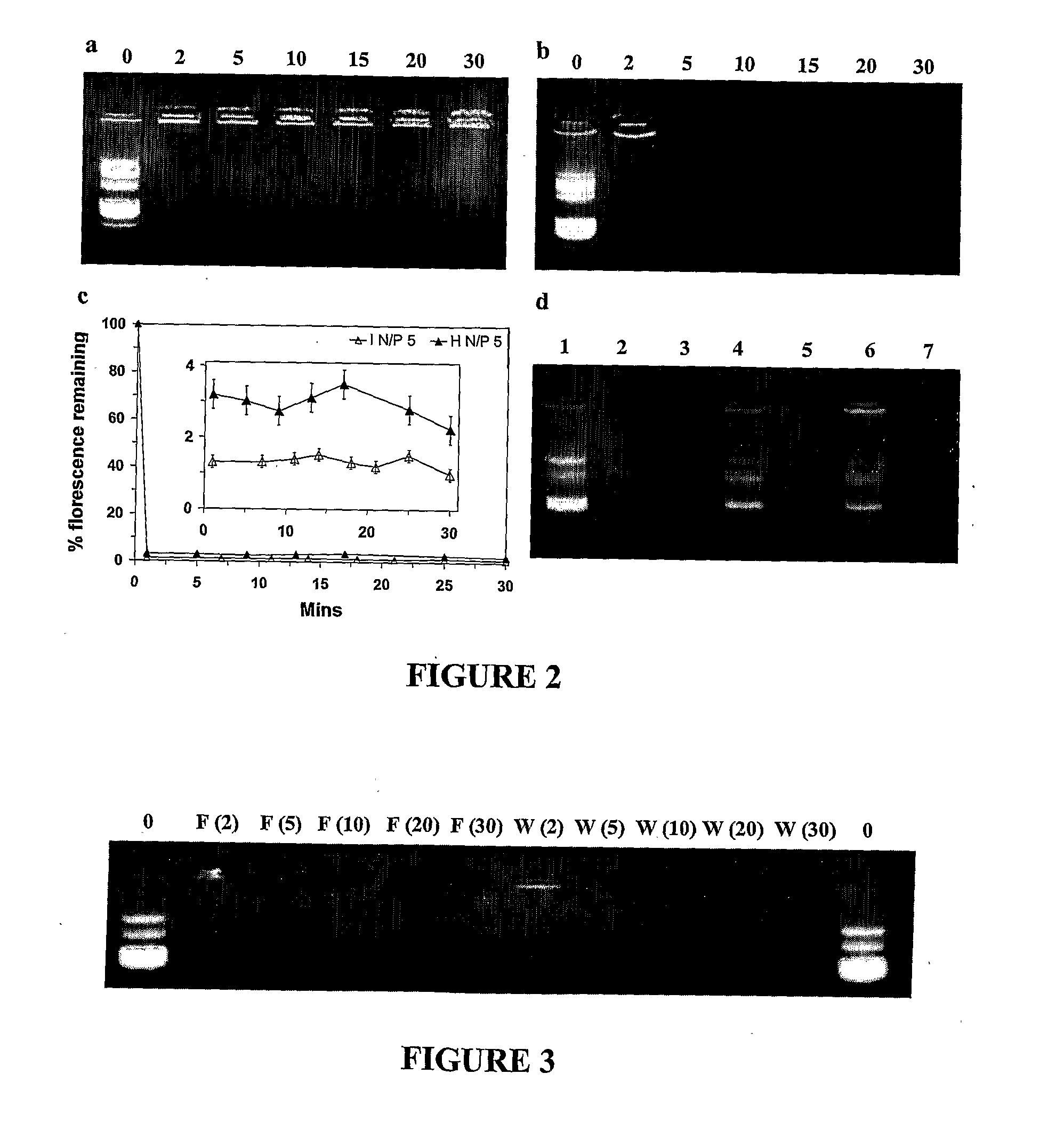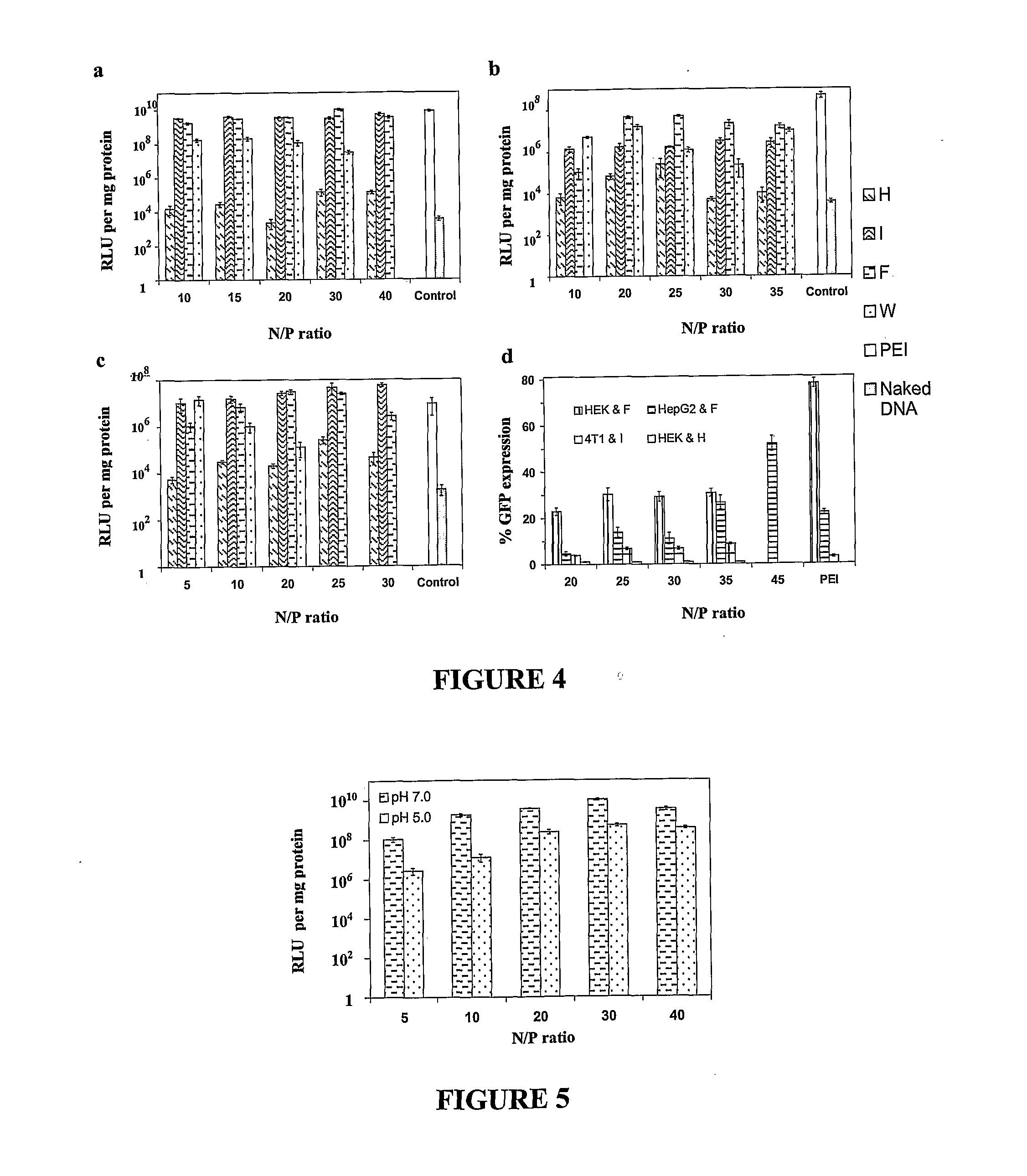Cationic peptide for delivering an agent into a cell
a technology of cationic peptides and agents, applied in the direction of peptides/protein ingredients, peptides, immunoglobulins, etc., can solve the problems of limited success of these materials, cytotoxic effects of these materials on target eukaryotic cells, etc., to achieve biodegradability, less toxic, and high gene transfection efficiency
- Summary
- Abstract
- Description
- Claims
- Application Information
AI Technical Summary
Benefits of technology
Problems solved by technology
Method used
Image
Examples
example 1
[0107]Here, short triblock oligopeptides were designed (17 amino acid residues, i.e. F5H4R8, I5H4R8, W5H4R8). These peptide vectors induced efficient gene expression in various cell lines at levels that are comparable or even superior to the gold standard of polyethylenimine (PEI). The functionality of each block is essential for achieving high transfection efficiency, and the eventual level of expression can be further influenced by the degree of hydrophobicity of the hydrophobic block. Notably, the peptide I5H4R8 mediates gene expression in a mouse breast cancer model much more efficiently than PEI. This approach of incorporating both hydrophobic and pH-sensitive amino acids within a cationic peptide structure therefore results in useful vectors for gene delivery.
[0108]Materials and Methods
[0109]Materials: 3-(4,5-Dimethylthiazol-2-yl)-2,5-diphenyltetrazoliumbromide (MTT), branched polyethylenimine (PEI, Mw˜25,000), deoxyribonuclease I (DNAse), chloroquine and bafilomycin A1 were a...
example 2
[0138]In this study, peptide amphiphile molecular constructs, (A)12(H)5(K)10 (AK27) and (A)12(H)5(K)15 (AK32), were designed from three blocks of amino acid residues, L-alanine, L-histidine, and L-lysine, and tested for efficacy as non-viral gene vectors. The amphiphilic constructs were able to self-assemble at concentration higher than 120 mg / L, which was estimated to be the CMC of the peptide in aqueous solution. The peptides were firstly characterized in terms of their particle sizes and zeta potentials. In the form of complex with plasmid DNA (pDNA), AK27 / pDNA complex forms nanoparticles with the smallest size of around 248 nm at N / P ratio 40, whereas AK32 / pDNA forms ones with the smallest size around 332 nm at N / P ratio 30. Similarly, the zeta potentials of the complexes were measured to be positive, and the highest surface charge of AK27 / pDNA and AK32 / pDNA were found to be 7.8 mV and 18.2 mV, both occurring at N / P ratio 40. In addition, peptide / pDNA complex nanoparticles forme...
PUM
| Property | Measurement | Unit |
|---|---|---|
| pH | aaaaa | aaaaa |
| pH | aaaaa | aaaaa |
| pKa | aaaaa | aaaaa |
Abstract
Description
Claims
Application Information
 Login to View More
Login to View More - R&D
- Intellectual Property
- Life Sciences
- Materials
- Tech Scout
- Unparalleled Data Quality
- Higher Quality Content
- 60% Fewer Hallucinations
Browse by: Latest US Patents, China's latest patents, Technical Efficacy Thesaurus, Application Domain, Technology Topic, Popular Technical Reports.
© 2025 PatSnap. All rights reserved.Legal|Privacy policy|Modern Slavery Act Transparency Statement|Sitemap|About US| Contact US: help@patsnap.com



